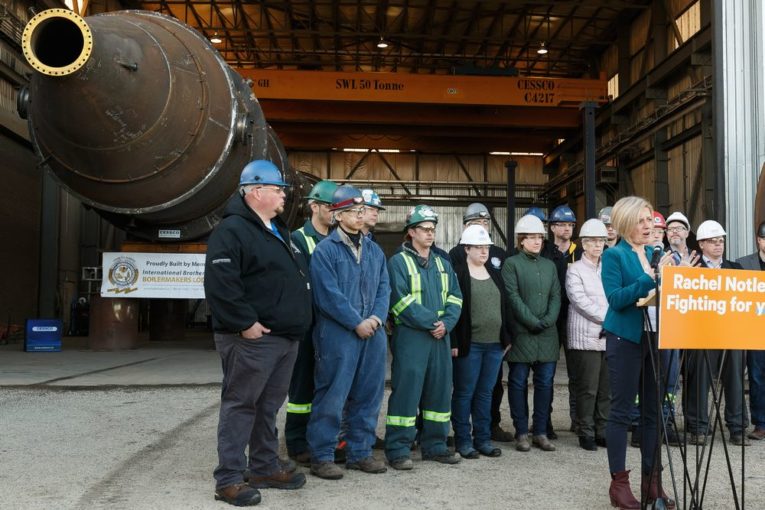
I could spend time arguing about the risks of the NDP’s campaign promise to double down on its energy diversification strategy by offering more subsidies to industry.
But I’ll let others do the job, such as a senior Alberta bureaucrat.
Or legendary oilman Jim Gray.
“Given the current fiscal situation … it would be questionable to introduce subsidies to the petrochemical industry at this point,” stated a ministerial briefing note prepared for Finance Minister Joe Ceci in November 2015 about the idea of offering incentives to kick-start petrochemical sector investment.
“This proposed incentive program cannot be justified on economic merit alone.”
Ouch.
The advice from the unnamed senior civil servant, in a memo obtained by the Canadian Taxpayers Federation, was written in response to a proposal to offer $500 million in grants or royalty tax credits to coax more investment into Alberta’s petrochemical industry.
The NDP eventually unveiled a different program to provide $500 million in royalty credits in late 2016, triggering two large petrochemical facilities to be built in Alberta’s Industrial Heartland area.
Last year, the provincial government expanded its energy diversification efforts to offer more subsidies, including grants and loan guarantees, to entice development of partial upgrading facilities, more petrochemical complexes and new natural gas infrastructure.
It pushed the costs to $3.6 billion.
On the election campaign trail Wednesday, NDP Leader Rachel Notley doubled the amount, promising to boost the incentives to $7 billion over the next decade if her party wins the April 16 election.
“It’s time we start acting like resource owners once again in Alberta, as we did under Premier Lougheed,” Notley said in a statement.
The NDP maintains the idea will eventually trigger 70,000 jobs and stimulate $75 billion in investment by 2030.
It sounds alluring, until you hear the other side.
Here’s another zinger from the internal government document.
“Alberta’s tax system is focused on keeping taxes low for all industries. The proposed incentive program means government is selecting certain stakeholders to receive direct support,” it states.
“There is no guarantee that the incentive program will actually lead to additional investment and could benefit projects that would have gone ahead regardless of the incentives.”
Now, the first phase of the program did succeed in attracting private-sector investment.
Inter Pipeline is building a $3.5-billion petrochemical plant after being offered up to $200 million in royalty tax credits.
Calgary-based Pembina Pipeline is teaming up with the petrochemical unit of Kuwait Petroleum Corp. to build a $4.5-billion dehydrogenation and polypropylene facility.
It made the decision after being offered up to $300 million in royalty tax credits, which are only paid out once the plant is operating.
NDP officials say of the remaining $950 million available under the existing petrochemical diversification program, it’s hoping to stimulate construction of massive ethane-cracking plants.
“We are seriously considering two proposals for world-scale ethane (crackers) that would double our current ethane production,” said one campaign official.
Two such complexes could see an investment worth an estimated $18 billion, potentially leveraged by $950 million in incentives, he said.
But where does Alberta draw the line in the game of offering subsidies to a few private-sector players?
And how could the public money be better used? There are many demands on the public purse.
“Get the economic fundamentals right, cut the red tape, get investment confidence back in Alberta, instead of picking a handful of winners and losers,” United Conservative Party Leader Jason Kenney told reporters when asked about the program.
Putting taxpayer money on the table through loan guarantees and grants carries a degree of risk, as was seen in the losses Albertans endured in the 1990s with the bi-provincial upgrader.
The province invested $404 million and sold out its position for $32 million four years later.
“History within Alberta has shown us these economic diversification government-led projects have burned Albertans,” said Franco Terrazzano of the Canadian Taxpayers Federation.
The NDP points out the internal government analysis from 2015 is stale – dated almost four years ago — and economic conditions have changed, as did the program.
Natural gas supplies are plentiful and the province has cheap feedstock to entice petrochemical industry investment.
A more compelling case can be made for investing in new partial upgrading technology, which would lower greenhouse gas emissions and reduce the amount of diluent needed to ship bitumen by pipeline, benefiting many players in the oilpatch, not just one company.
However, the NDP contends a broad energy diversification strategy is needed to add greater value to our natural resources and more jobs in Alberta.
They frequently invoke the name of former Tory premier Lougheed, who succeeded in expanding the petrochemical industry more than four decades ago by using incentives and other government assurances.
Today, other jurisdictions in the United States are offering even larger incentives.
Without them, no facilities have been built in Alberta over the past two decades, said David Chappell, chair of the Resource Diversification Council, which represents petrochemical and midstream companies.
But these arguments don’t convince Gray, co-founder of Canadian Hunter Exploration and a friend of Lougheed’s.
A member of the Canadian Business Hall of Fame, Gray points out the Lougheed government had some successes adding value to Alberta’s resources, but there were also costly missteps.
“Whenever there has to be a subsidy or has to be tax credits or royalty credits, whatever, you can almost be assured those things are sailing into difficult water,” he said Thursday.
“It’s a dangerous game and you play it at your risk.”
I couldn’t have said it better myself.
Chris Varcoe is a Calgary Herald columnist.
You can read more of the news on source
